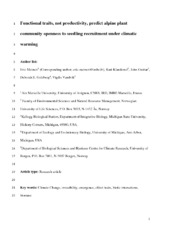Functional traits, not productivity, predict alpine plant community openness to seedling recruitment under climatic warming
Peer reviewed, Journal article
Accepted version
Permanent lenke
http://hdl.handle.net/1956/22616Utgivelsesdato
2020Metadata
Vis full innførselSamlinger
Sammendrag
Understanding the degree to which plant communities are open to seedling recruitment is key to predicting how they will be impacted by climate change. We experimentally assessed whether communities assembled under colder climates were inherently more open to recruitment than warmer‐climate communities, after controlling for differences in the current climate under which the communities were growing. We then tested whether variation in openness to recruitment could be explained by community biomass or by the plant functional traits of the community. The study was conducted in a climate grid of twelve grassland sites across southern Norway, differing systematically in temperature and precipitation. Along a 2000 mm precipitation gradient, we transplanted turfs with intact plant communities from alpine and sub‐alpine sites into 2°C warmer sites, and measured natural seedling emergence in these transplanted turfs versus locally replanted control turfs at the transplant destination sites. Mixed effect models were used to assess the effect of origin (cold versus warm climate), biomass, and functional trait composition of the communities on seedling emergence. We further assessed variation in these effects across different climatic contexts (the temperature and precipitation gradients). Communities originating from colder climates were consistently more open to recruitment, with on average 44% more seedlings emerging, than the locally replanted control communities. The higher rates of seedling emergence in colder‐climate communities were attributable to systematic differences in plant functional traits, but not in biomass. The colder‐climate communities were composed of species with smaller leaves and lower maximum plant heights; traits that may make these communities less effective at excluding new recruits. These trait‐related responses were not significant in the warmest sites and did not very across the precipitation gradient. Our results suggest that alpine species lack the competitive effect traits required to make their communities resistant to invasion by novel competitors under climate change.
